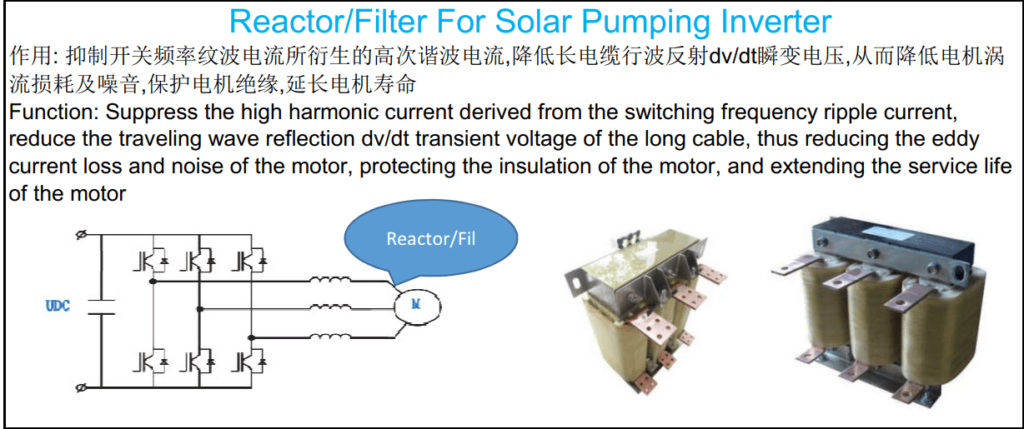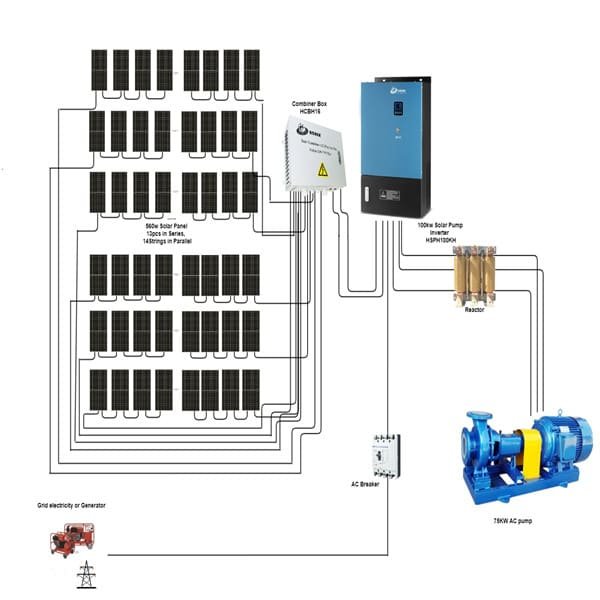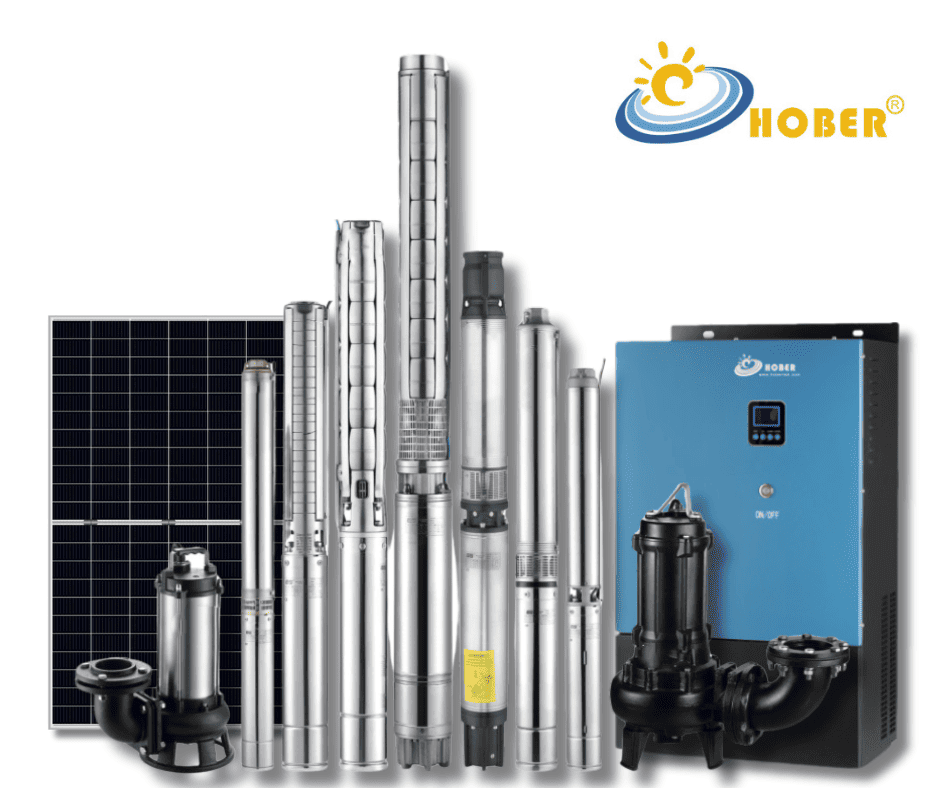مقدمة
تُحدث مضخات المياه بالطاقة الشمسية ثورة في الوصول إلى المياه وتوزيعها، خاصة في المناطق النائية وخارج الشبكة. هذه الأنظمة مستدامة وفعالة من حيث التكلفة وصديقة للبيئة. ومع ذلك، قد يكون ضمان تشغيلها بكفاءة أمرًا صعبًا في بعض الأحيان، خاصة مع خطوط الضخ الطويلة. إحدى المشكلات الحرجة المتعلقة بخطوط المضخة التي يتجاوز طولها 100 متر هي الزيادة الكبيرة في ذروة الجهد، والتي يمكن أن تسبب ضررًا كبيرًا للمضخة وتؤدي إلى فقدان كبير للطاقة. تستكشف هذه المقالة سبب أهمية تركيب مفاعل في مثل هذه السيناريوهات، وحماية المضخة وتعزيز كفاءتها.

فهم مضخات المياه بالطاقة الشمسية
ما هي مضخات المياه بالطاقة الشمسية؟
تستخدم مضخات المياه بالطاقة الشمسية الطاقة الشمسية لضخ المياه، وعادة ما تستخدم في التطبيقات الزراعية والمنزلية والصناعية حيث لا تتوفر طاقة الشبكة أو لا يمكن الاعتماد عليها. تقوم هذه المضخات بتحويل الطاقة الشمسية إلى طاقة كهربائية باستخدام الألواح الكهروضوئية، والتي تعمل بعد ذلك على تشغيل المحرك لضخ المياه.
كيف يعملون؟
تبدأ العملية بألواح شمسية تلتقط ضوء الشمس وتحوله إلى كهرباء. تعمل هذه الكهرباء على تشغيل المحرك الذي يحرك المضخة، التي ترفع أو تنقل المياه من المصدر إلى الوجهة المطلوبة. تعتمد كفاءة مضخات المياه بالطاقة الشمسية على عوامل مثل جودة الألواح الشمسية، والمضخة، والتصميم العام للنظام.
التحديات في خطوط ضخ المياه بالطاقة الشمسية الطويلة
تعريف خطوط ضخ المياه بالطاقة الشمسية الطويلة
يعتبر خط ضخ المياه بالطاقة الشمسية طويلًا عندما يتجاوز طوله 100 متر. وهذه الخطوط الممتدة شائعة في الحقول الزراعية والعقارات الكبيرة حيث تحتاج المياه إلى النقل لمسافات كبيرة.
القضايا المشتركة التي تواجهها
تشمل التحديات الأساسية التي تواجه خطوط المضخة الطويلة زيادة المقاومة الكهربائية، وجهد الذروة العالي، وفقدان الطاقة بشكل كبير. يمكن أن تقلل هذه المشكلات من كفاءة المضخة وتزيد من خطر التلف.
مشكلة ذروة الجهد
شرح ذروة الجهد
يشير جهد الذروة إلى الحد الأقصى لمستوى الجهد في الدائرة الكهربائية. في خطوط ضخ المياه بالطاقة الشمسية الطويلة، يمكن أن يصبح جهد الذروة مرتفعًا بشكل ملحوظ بسبب زيادة المقاومة وطول الخط.
التأثير على مضخات المياه بالطاقة الشمسية
يمكن أن يؤدي ارتفاع جهد الذروة إلى العديد من المشكلات، بما في ذلك ارتفاع درجة حرارة المحرك، وانهيار العزل، وفي النهاية فشل المضخة. إنه يشكل خطراً جسيماً على طول عمر وموثوقية نظام ضخ المياه بالطاقة الشمسية.
أضرار جسيمة للمضخة
أنواع الأضرار الناجمة عن ارتفاع ذروة الجهد
يمكن أن يسبب الجهد العالي الذروة أنواعًا مختلفة من الضرر:
- ارتفاع درجة حرارة المحرك: الحرارة المفرطة يمكن أن تلحق الضرر بلفات المحرك وتقلل من عمرها الافتراضي.
- انهيار العزل: يمكن أن يؤدي الجهد العالي إلى تحلل المواد العازلة، مما يؤدي إلى حدوث دوائر قصيرة.
- ارتداء المكونات: التعرض لفترات طويلة للجهد العالي يمكن أن يؤدي إلى تسريع تآكل المكونات الميكانيكية.
دراسات الحالة / الأمثلة
في إحدى الحالات، شهدت مزرعة في كينيا أعطالًا متكررة للمضخة بسبب ارتفاع الجهد الأقصى في خط المضخة الذي يبلغ طوله 150 مترًا. وبعد تركيب المفاعل، شهدت المزرعة انخفاضًا كبيرًا في تلف المضخة وتكاليف الصيانة.
خسارة كبيرة في الطاقة
كيف يسبب الجهد الذروة فقدان الطاقة
يزيد جهد الذروة المرتفع من المقاومة الكهربائية في خط المضخة، مما يؤدي إلى زيادة استهلاك الطاقة وفقدان الطاقة. وهذا لا يقلل من كفاءة المضخة فحسب، بل يزيد أيضًا من تكاليف التشغيل.
التأثيرات على الكفاءة والتكلفة
ويترجم فقدان الطاقة إلى ارتفاع تكاليف الطاقة وانخفاض إنتاج المياه. بالنسبة للعمليات واسعة النطاق، يمكن أن يكون لذلك تأثير مالي كبير.
دور المفاعل

ما هو المفاعل؟
المفاعل، في سياق أنظمة ضخ المياه بالطاقة الشمسية، هو مكون كهربائي يساعد على إدارة وتقليل ذروة الجهد. إنه يعمل بشكل مشابه للمحث، حيث يعمل على تنعيم طفرات الجهد وضمان تدفق كهربائي أكثر استقرارًا.
كيف يعمل؟
تعمل المفاعلات عن طريق إدخال مفاعلة حثية في الدائرة، والتي تتصدى للتغيرات المفاجئة في التيار. يساعد ذلك في الحد من ذروة الجهد وحماية المضخة من التلف المحتمل.
فوائد تركيب مفاعل
تقليل ذروة الجهد
عن طريق تركيب مفاعل، يتم تقليل الجهد الأقصى في خط المضخة بشكل كبير. وهذا يساعد على منع ارتفاع درجة حرارة المحرك وانهيار العزل.
تقليل فقدان الطاقة
تساعد المفاعلات على تقليل المقاومة الكهربائية، وبالتالي تقليل فقد الطاقة وتحسين الكفاءة العامة لنظام المضخة.
تعزيز حماية المضخة
مع وجود المفاعل في مكانه، تكون مضخة المياه بالطاقة الشمسية محمية بشكل أفضل ضد ارتفاع الجهد الكهربائي والارتفاعات الكهربائية، مما يؤدي إلى عمر أطول وتشغيل أكثر موثوقية.
المواصفات الفنية للمفاعلات
أنواع المفاعلات المناسبة لمضخات المياه بالطاقة الشمسية
- المفاعلات الهوائية: مناسبة للتطبيقات عالية التردد.
- مفاعلات الحديد الأساسية: توفير محاثة أعلى ومناسبة لتطبيقات التردد المنخفض.
- مفاعلات من النوع الجاف: مثالية للمنشآت في الهواء الطلق والبيئات القاسية.
إرشادات التثبيت
التثبيت السليم أمر بالغ الأهمية لتحقيق الأداء الأمثل. يتضمن ذلك ضمان الموضع الصحيح والتوصيلات الكهربائية المناسبة وفحوصات الصيانة الدورية.
دراسة الحالة: التنفيذ الناجح
مثال واقعي لتركيب المفاعل
واجه تركيب مضخة مياه تعمل بالطاقة الشمسية في الهند مشكلات خطيرة في الكفاءة بسبب خط المضخة الذي يبلغ طوله 200 متر. بعد تركيب مفاعل ذو قلب حديدي، انخفض الجهد الأقصى بمقدار 40%، وانخفض فقدان الطاقة بمقدار 30%. وأدى ذلك إلى تشغيل المضخة بشكل أكثر استقرارًا وكفاءة، مع انخفاض ملحوظ في متطلبات الصيانة.
النتائج والفوائد التي لوحظت
وشهد التثبيت فوائد فورية، بما في ذلك تقليل وقت التوقف عن العمل، وانخفاض تكاليف الصيانة، وتحسين إنتاج المياه. وقد أتى الاستثمار في المفاعل بثماره في غضون عام من خلال توفير الطاقة وخفض تكاليف الإصلاح.
الصيانة والمراقبة
كيفية صيانة المفاعلات
الصيانة الدورية تشمل:
- التفتيش البصري: التحقق من الأضرار المادية أو التآكل.
- الاختبارات الكهربائية: التأكد من عمل المفاعل بشكل صحيح.
- تنظيف: الحفاظ على المفاعل والمناطق المحيطة به خالية من الغبار والحطام.
مراقبة الأداء الأمثل
تتضمن المراقبة المستمرة استخدام أجهزة الاستشعار وأنظمة التحكم لتتبع أداء المفاعل ونظام المضخة. يجب معالجة أي حالات شاذة على الفور لتجنب المشكلات المحتملة.
تحليل التكاليف والفوائد
الاستثمار الأولي مقابل الادخار طويل الأجل
في حين أن التكلفة الأولية لتركيب مفاعل قد تبدو مرتفعة، فإن التوفير على المدى الطويل نتيجة لانخفاض فقدان الطاقة، وانخفاض تكاليف الصيانة، وتحسين عمر المضخة، يجعل منه استثمارًا مفيدًا.
العائد على الاستثمار (ROI)
يمكن تحقيق عائد الاستثمار لتركيب مفاعل في نظام ضخ المياه بالطاقة الشمسية في غضون سنة إلى سنتين، اعتمادًا على حجم التركيب وظروف التشغيل.
آراء الخبراء
رؤى من المتخصصين في الصناعة
يؤكد الخبراء في صناعة مضخات المياه بالطاقة الشمسية على أهمية إدارة الجهد الأقصى لخطوط المضخة الطويلة. ويوصون بالمفاعلات كحل فعال لتعزيز موثوقية النظام وكفاءته.
الشهادات والتوصيات
صرح أحد مستشاري الطاقة الشمسية قائلاً: "إن تركيب مفاعل سيغير قواعد اللعبة بالنسبة لخطوط الضخ الطويلة. فهو لا يحمي المضخة فحسب، بل يضمن أيضًا الأداء المتسق وتوفير الطاقة.
أسئلة وأجوبة حول المفاعلات ومضخات المياه بالطاقة الشمسية
- ما هي الوظيفة الأساسية للمفاعل في نظام ضخ المياه بالطاقة الشمسية؟
- يساعد المفاعل على تقليل ذروة الجهد وتقليل فقدان الطاقة، مما يحمي المضخة ويعزز كفاءتها.
- كيف يؤدي الجهد الأقصى إلى إتلاف مضخة المياه بالطاقة الشمسية؟
- يمكن أن يتسبب ارتفاع الجهد الكهربي في ارتفاع درجة حرارة المحرك، وانهيار العزل، وزيادة تآكل المكونات الميكانيكية، مما يؤدي إلى فشل المضخة.
- هل المفاعلات مناسبة لجميع أنواع مضخات المياه بالطاقة الشمسية؟
- نعم، يمكن استخدام المفاعلات مع أنواع مختلفة من مضخات المياه بالطاقة الشمسية، ولكن يجب اختيار نوع المفاعل المحدد بناءً على متطلبات النظام.
- ما هي متطلبات الصيانة للمفاعلات؟
- تعتبر عمليات الفحص البصري المنتظم والاختبارات الكهربائية والتنظيف ضرورية للحفاظ على أداء المفاعل وطول عمره.
- كم من الوقت يستغرق رؤية فوائد تركيب مفاعل؟
- ويمكن ملاحظة الفوائد على الفور تقريبًا، بما في ذلك تقليل فقدان الطاقة وتحسين حماية المضخة. عادة ما يحدث العائد على الاستثمار في غضون 1-2 سنوات.
خاتمة
يعد تركيب مفاعل في خطوط ضخ المياه بالطاقة الشمسية التي يتجاوز طولها 100 متر أمرًا بالغ الأهمية للتخفيف من ذروة الجهد العالي وتقليل فقدان الطاقة. ومن خلال ضمان تشغيل أكثر استقرارًا وكفاءة، تعمل المفاعلات على حماية المضخة من التلف، وتقليل تكاليف التشغيل، وإطالة عمر النظام. وكما هو موضح في دراسات الحالة وآراء الخبراء، فإن فوائد تركيب مفاعل تفوق بكثير الاستثمار الأولي، مما يجعله عنصرًا أساسيًا لأي تركيب طويل لخط ضخ المياه بالطاقة الشمسية.

